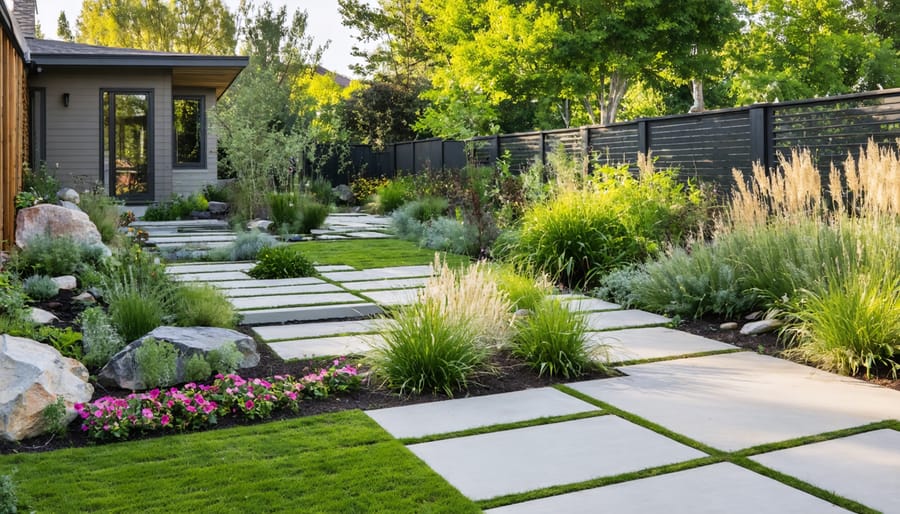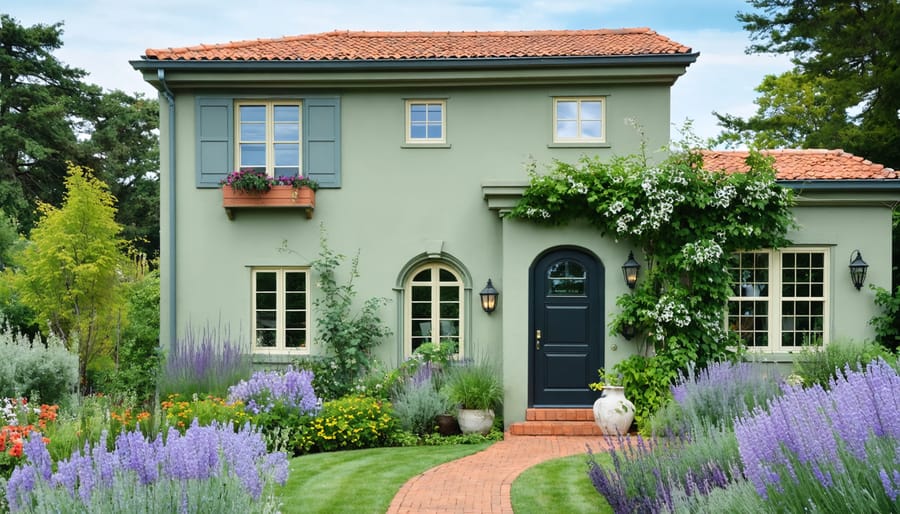Transform your landscape into a water-saving oasis by grouping plants with similar water needs, installing smart irrigation controllers, and replacing thirsty lawns with native groundcovers. Strategic placement of drought-tolerant perennials and ornamental grasses creates stunning visual impact while dramatically reducing water consumption – a key principle of successful eco-friendly garden transformation. Add a 2-3 inch layer of organic mulch around plants to retain moisture and suppress weeds, while incorporating permeable hardscaping materials like gravel or decomposed granite to maximize natural water absorption. These proven techniques not only cut water bills by up to 50% but also create resilient, low-maintenance landscapes that thrive in challenging climate conditions while providing year-round beauty.
Smart Design Principles for Water-Wise Gardens
Hydrozoning: Group Plants by Water Needs
Grouping plants based on their water needs isn’t just smart gardening – it’s a game-changer for water conservation and plant health. Think of your garden as a series of water zones, each with its own unique thirst level. By placing plants with similar water requirements together, you’ll create efficient irrigation zones that prevent both overwatering and underwatering.
Start by dividing your garden into three main zones: high, moderate, and low water use. The high-water zone might include lush perennials and water-loving plants, perfect for areas you see frequently, like near your entrance. Your moderate zone could feature adaptable plants like lavender and sage, which need occasional watering once established. The low-water zone is ideal for drought-tolerant natives and succulents that thrive with minimal irrigation.
Consider your yard’s natural characteristics when planning these zones. Places that naturally collect water or stay shady are perfect for thirstier plants, while sunny, exposed areas work well for drought-resistant varieties. Remember to group plants with similar root depths together – shallow-rooted groundcovers won’t compete well with deep-rooted shrubs for water.
When setting up your irrigation system, each zone should have its own valve and schedule. This way, you can deliver exactly the right amount of water to each group of plants without waste. As a bonus, this organized approach makes maintenance easier and helps you spot potential problems quickly.
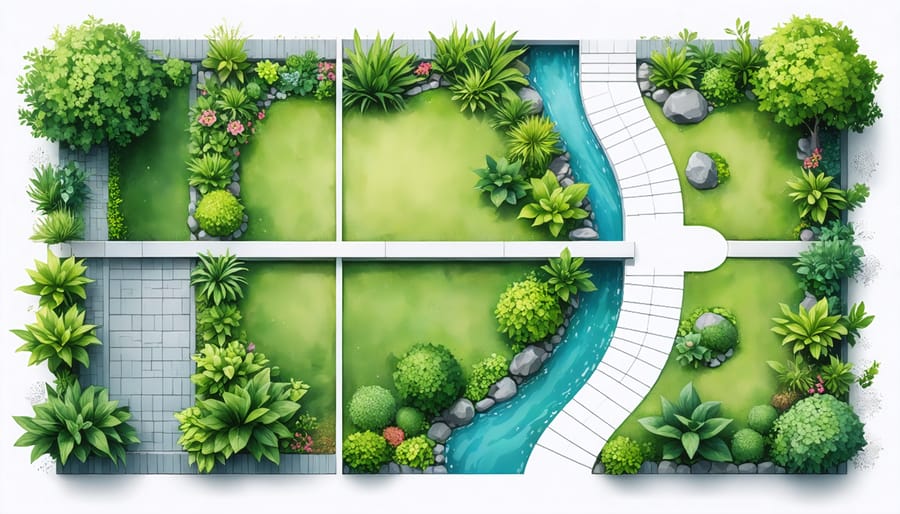
Creating Natural Water Flow
Creating natural water flow in your landscape isn’t just about managing rainwater – it’s about working with nature to create a sustainable and beautiful garden. Think of your yard as a mini watershed, where every drop of water has a purpose and a path.
Start by observing how water naturally moves across your property during rainfall. Note where it pools, where it runs off quickly, and where it tends to soak in. This understanding will help you design with water flow in mind.
One of the most effective techniques is creating subtle swales – shallow, gently sloping channels that slow water down and guide it where you want it to go. These can be beautifully disguised with river rock and native plants, making them both functional and attractive.
Rain gardens are another fantastic solution. These slightly depressed areas, filled with water-loving plants, capture runoff from roofs and hard surfaces. They not only prevent flooding but also create vibrant habitat spaces for local wildlife.
Consider incorporating berms (raised areas) alongside your swales to further direct water flow. These can be planted with drought-resistant species that thrive in well-drained soil. For steep slopes, terracing helps prevent erosion while creating interesting visual layers in your landscape.
Remember to position plants strategically – place those with higher water needs in natural collection areas, and drought-tolerant varieties on higher ground or berms. This approach maximizes natural rainfall and reduces the need for supplemental watering.
Drought-Tolerant Plant Selection
Native Plants That Thrive With Less Water
Choosing native plants that save time and money is one of the smartest moves you can make for a water-wise landscape. These botanical champions have evolved to thrive in your local climate, requiring minimal supplemental watering once established.
For sunny areas, consider drought-resistant beauties like Black-Eyed Susans, Purple Coneflowers, and Butterfly Weed. These hardy perennials not only add vibrant colors to your garden but also attract beneficial pollinators. In shadier spots, native ferns, Wild Ginger, and Solomon’s Seal naturally adapt to existing moisture levels.
Native grasses like Little Bluestem and Switch Grass develop deep root systems that help them survive dry spells while preventing soil erosion. These graceful plants add movement and year-round interest to your landscape, looking especially stunning when backlit by the morning or evening sun.
Ground covers such as Creeping Thyme and Wild Strawberry create dense mats that shade the soil, reducing evaporation and suppressing weeds. They’re perfect for replacing thirsty lawns in areas where foot traffic is minimal.
Before selecting plants, observe your yard’s microclimates – areas that differ in sun exposure, wind patterns, and natural moisture retention. Group plants with similar water needs together, creating efficient hydrozones that make watering more effective. Remember that even drought-tolerant plants need regular watering during their first growing season to establish strong roots. After that, they’ll reward you with years of low-maintenance beauty while conserving precious water resources.
Ornamental Choices for Every Season
Creating a vibrant garden doesn’t mean sacrificing water efficiency. With careful selection of drought-resistant ornamentals, you can enjoy stunning blooms and interesting foliage throughout the year. Let’s explore some beautiful options for each season.
Spring brings the cheerful blooms of salvias, with their spiky purple flowers attracting beneficial pollinators. Pair these with the silver-gray foliage of lamb’s ears, which adds soft texture and visual interest. Russian sage offers delicate purple sprays that dance in spring breezes while requiring minimal water.
Summer stars include the hardy lavender, providing both fragrance and color. Yarrow, with its flat-topped flower clusters in yellow, white, or pink, thrives in hot conditions. For dramatic impact, consider red-hot poker plants, whose torch-like blooms make bold statements in any water-wise garden.
As autumn approaches, ornamental grasses come into their own. Mexican feather grass catches light beautifully and moves gracefully in the wind. Sedum ‘Autumn Joy’ develops deep pink flower heads that persist well into winter, providing food for late-season pollinators.
Winter needn’t be dull in a water-wise landscape. Evergreen options like rosemary maintain structure year-round while offering culinary benefits. For color, consider hellebores, which produce elegant blooms during the coldest months despite minimal water needs.
For year-round texture, incorporate succulents like sempervivum (hens and chicks) or agave. These architectural plants create strong focal points and thrive with little attention. Remember to group plants with similar water needs together to maximize efficiency while maintaining visual harmony throughout the seasons.
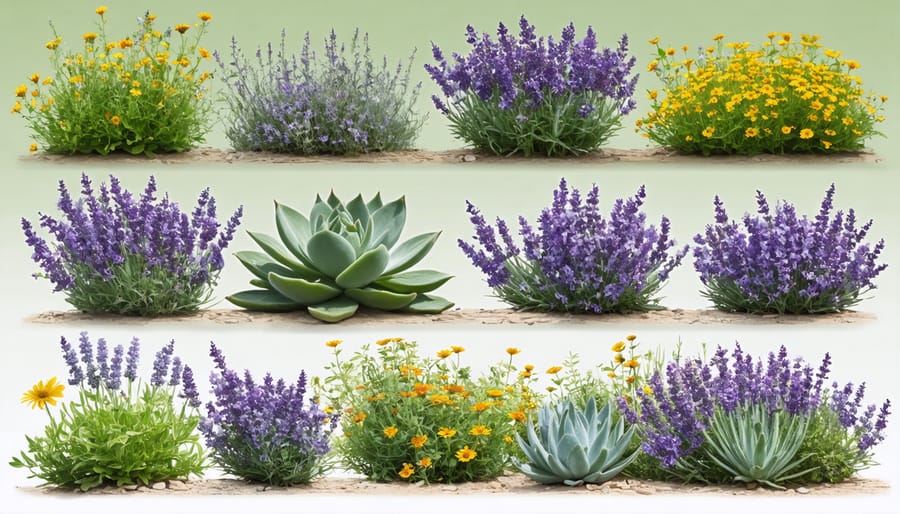
Smart Irrigation Solutions
Modern Irrigation Technologies
Modern irrigation technologies have revolutionized the way we water our gardens, making it easier than ever to maintain a beautiful landscape while conserving water. At the heart of these innovations is the drip irrigation system, which delivers water directly to plant roots through small tubes and emitters. This targeted approach reduces water waste from evaporation and overspray, while keeping leaves dry to discourage fungal diseases.
Smart irrigation controllers have become game-changers for busy gardeners. These clever devices connect to local weather stations and automatically adjust watering schedules based on rainfall, temperature, and seasonal changes. Some models even let you control your irrigation system from your smartphone, giving you the flexibility to make adjustments when you’re away from home.
Soil moisture sensors are another fantastic addition to any water-wise garden. These sensors monitor the moisture level in your soil and communicate with your irrigation controller to prevent overwatering. By only watering when necessary, you’ll save water and promote healthier root growth. Many gardeners find that installing moisture sensors can reduce their water usage by 30-50%.
For those new to modern irrigation, start with a simple drip system in one area of your garden. As you become more comfortable with the technology, you can expand your system and add smart features. Remember, even the most basic drip irrigation setup will be more efficient than traditional sprinklers, making it a worthwhile investment for any water-conscious gardener.
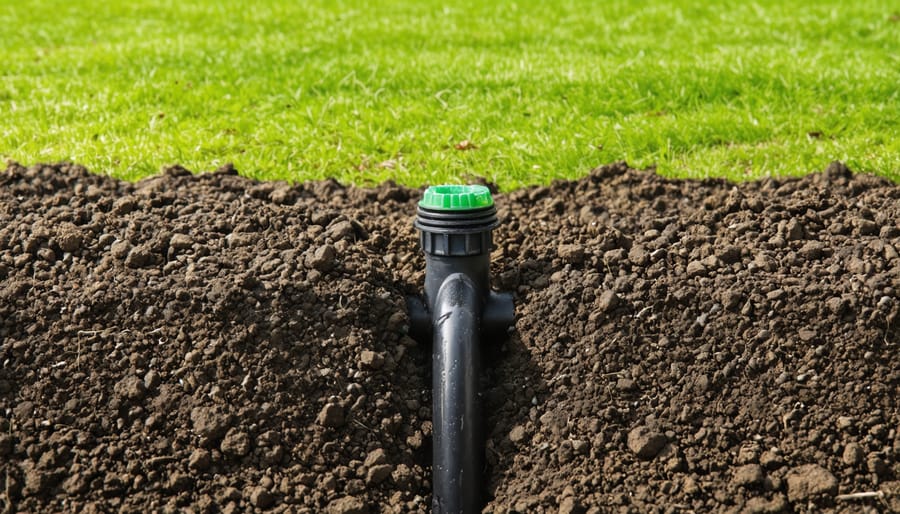
Watering Schedule Optimization
Timing is everything when it comes to efficient watering, and getting it right can significantly reduce water waste while keeping your plants healthy. The best time to water is early morning, ideally between 5 AM and 9 AM, when temperatures are cooler and winds are calmer. This timing allows water to penetrate the soil before evaporation becomes a factor.
Rather than light, frequent watering, opt for deep, infrequent sessions that encourage roots to grow deeper into the soil. Most established plants thrive with 1-2 deep waterings per week during growing seasons. However, adjust this schedule based on your climate, soil type, and plant needs.
Monitor soil moisture by inserting your finger about 2 inches into the soil – if it feels dry at this depth, it’s time to water. Smart irrigation controllers can take the guesswork out of watering by automatically adjusting schedules based on weather conditions and soil moisture levels.
During cooler months or rainy seasons, reduce watering frequency accordingly. New plants need more frequent watering until established, typically for the first few weeks after planting. Group plants with similar water needs together to prevent overwatering some while underwatering others.
Remember to adjust sprinkler timers seasonally and after significant rainfall. A rain sensor can automatically skip scheduled watering when nature provides adequate moisture, making your irrigation system truly water-wise.
Soil and Mulch Management
Good soil management is the foundation of any water-wise landscape, acting like a natural reservoir for your plants. By improving your soil structure and using proper mulching techniques, you can significantly reduce water waste while keeping your garden thriving.
Start by getting to know your soil. Sandy soils drain quickly but don’t retain moisture well, while clay soils hold water but can become compacted. The ideal soil for water-wise gardening has a good balance of organic matter, which helps retain moisture while maintaining proper drainage. Adding compost to your existing soil is one of the best ways to achieve this balance – aim for about 2-3 inches worked into the top 6-8 inches of soil.
Mulching is your secret weapon in water-wise landscaping. A 2-3 inch layer of organic mulch can reduce water evaporation by up to 70% and keep soil temperatures more stable. Popular mulch options include:
– Shredded bark or wood chips
– Straw or hay (perfect for vegetable gardens)
– Pine needles (great for acid-loving plants)
– Compost
– Leaves
Apply mulch around plants, trees, and in garden beds, but keep it a few inches away from plant stems and tree trunks to prevent rot. Refresh your mulch layer annually, as it naturally breaks down and enriches the soil.
For sloped areas, consider using erosion-control mulches or installing terraces to help slow water runoff and increase absorption. In particularly hot or exposed areas, you might want to add an extra inch of mulch to provide additional protection against evaporation.
Remember to avoid creating a solid barrier with your mulch – water should still be able to penetrate easily. When watering, make sure the water reaches the soil beneath the mulch layer. This encourages deeper root growth, making plants more resilient during dry spells.
With proper soil preparation and mulching, you’ll create a foundation that helps your plants thrive while using less water. These simple techniques pay dividends in both water savings and reduced maintenance time.
Transforming your landscape into a water-wise oasis is an exciting journey that benefits both your wallet and the environment. As we’ve explored throughout this guide, creating a sustainable garden doesn’t mean sacrificing beauty or settling for a barren yard. By implementing thoughtful plant selection, efficient irrigation systems, and budget-friendly garden designs, you can create a stunning outdoor space that thrives with minimal water consumption.
Remember, every small change matters. Start by incorporating drought-resistant plants in one area of your garden, then gradually expand your water-wise approach. Experiment with different mulching techniques, and don’t be afraid to adjust your irrigation schedule as you learn what works best for your specific climate and soil conditions.
The rewards of water-wise landscaping extend far beyond conservation. You’ll spend less time on maintenance, save money on water bills, and create a resilient garden that looks beautiful year-round. Plus, you’ll join a growing community of environmentally conscious gardeners making a positive impact on our planet.
Take that first step today. Whether you’re starting small with a few native plants or planning a complete landscape transformation, your journey toward a water-wise garden is a valuable investment in your property and our environment’s future. Happy gardening!

